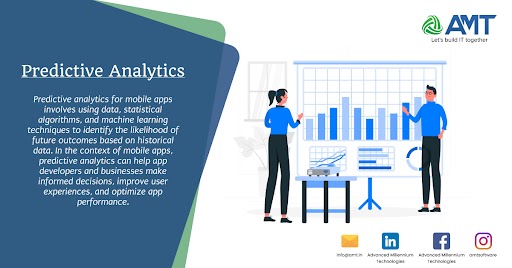Predictive analytics for mobile apps involves using data, statistical algorithms, and machine learning techniques to identify the likelihood of future outcomes based on historical data. In the context of mobile apps, predictive analytics can help app developers and businesses make informed decisions, improve user experiences, and optimize app performance. Here are some ways predictive analytics can be applied to mobile apps:
- User Behavior Prediction:
- Analyzing historical user data to predict future behavior. For example, predicting which features users are likely to engage with, how often they will use the app, or when they might churn.
- Personalization:
- Using predictive analytics to tailor the app experience for individual users. This could involve recommending content, products, or features based on the user’s historical behavior and preferences.
- Churn Prediction:
- Identifying users who are at risk of uninstalling or discontinuing app usage. Predictive models can analyze user activity patterns and other relevant data to flag potential churners, allowing businesses to take proactive measures to retain users.
- App Performance Optimization:
- Predicting potential issues with app performance, such as crashes or slow loading times. This enables developers to address issues before they impact user satisfaction and app ratings.
- Customer Segmentation:
- Using predictive analytics to group users into segments based on common characteristics. This allows businesses to target specific user groups with tailored marketing strategies or app features.
- In-App Purchases and Monetization:
- Predicting which users are more likely to make in-app purchases. This information can be used to optimize pricing strategies, offer targeted promotions, or enhance the overall monetization strategy.
- Fraud Detection:
- Predictive analytics can help identify patterns associated with fraudulent activities, such as account takeovers or fake transactions, protecting both users and the app’s revenue streams.
- App Usage Forecasting:
- Predicting future trends in app usage, such as peak usage times or seasonal variations. This information can be valuable for resource allocation, server capacity planning, and marketing efforts.
- Sentiment Analysis:
- Analyzing user reviews and feedback to predict overall user sentiment. This helps businesses understand how users perceive their app and make improvements based on feedback.
- Location-Based Predictions:
- Leveraging location data to predict user behavior or offer location-specific recommendations. For example, suggesting nearby events or promotions based on a user’s current location.
Implementing predictive analytics in mobile apps typically involves collecting and analyzing large sets of data, utilizing machine learning algorithms, and integrating the insights gained into the app’s development and marketing strategies. It’s important to prioritize user privacy and adhere to data protection regulations when implementing predictive analytics features in mobile apps.
Above is just a brief, watch this space for more updates on the latest trends in Technology.
